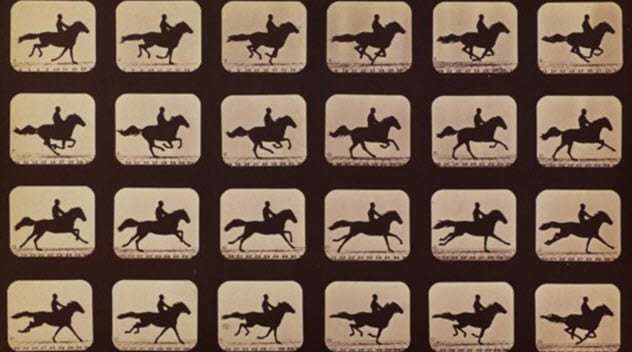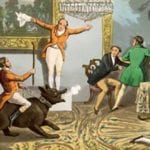 Mysteries
Mysteries  Mysteries
Mysteries  History
History 10 Surprising Stories About the Texas Rangers
 Humans
Humans 10 Philosophers Who Were Driven Mad by Their Own Theories
 Miscellaneous
Miscellaneous 10 Video-Game-Worthy Weapons and Armors from History
 Weird Stuff
Weird Stuff 10 Psychics Who Accurately Predicted Wartime Events
 The Arts
The Arts 10 Pieces of Art Inspired by a Broken Heart
 Health
Health 10 Science Fiction-Sounding New Medical Treatments
 History
History 10 Surprising Facts About the Father of Submarine Warfare
 Space
Space Ten Astonishing New Insights into Alien Worlds
 Weird Stuff
Weird Stuff 10 Bizarre Summer Solstice Rituals Still Practiced Today
 Mysteries
Mysteries Top 10 Haunting Facts About the Ghost Ship MV Alta
 History
History 10 Surprising Stories About the Texas Rangers
 Humans
Humans 10 Philosophers Who Were Driven Mad by Their Own Theories
Who's Behind Listverse?

Jamie Frater
Head Editor
Jamie founded Listverse due to an insatiable desire to share fascinating, obscure, and bizarre facts. He has been a guest speaker on numerous national radio and television stations and is a five time published author.
More About Us Miscellaneous
Miscellaneous 10 Video-Game-Worthy Weapons and Armors from History
 Weird Stuff
Weird Stuff 10 Psychics Who Accurately Predicted Wartime Events
 The Arts
The Arts 10 Pieces of Art Inspired by a Broken Heart
 Health
Health 10 Science Fiction-Sounding New Medical Treatments
 History
History 10 Surprising Facts About the Father of Submarine Warfare
 Space
Space Ten Astonishing New Insights into Alien Worlds
 Weird Stuff
Weird Stuff 10 Bizarre Summer Solstice Rituals Still Practiced Today
10 Innocuous Things Created By Eccentric Mad Men
Everything you come in contact with has its own story. Familiarity has drained some items of any interest. However, when looking at even the most mundane things, there is almost always something surreal.
Just because that item is banal doesn’t mean that its history is. The people behind even the most mundane things lived lives that were anything but. Here’s hoping these dark and disturbing backstories can bring some excitement to these commonplace things.
10 A Stagecoach Accident Created Movies And A Murder

In 1860, Eadweard Muybridge was traveling through Texas on a stagecoach. When it crashed, he and the other passengers were thrown out. After hitting his head, Muybridge suffered from double vision, sensory impairments, and confused thinking.
To recuperate, his doctor told him to take up a new hobby to recover. Muybridge decided to get into photography. With bold and deadly stunts, he earned a reputation as one of the most acclaimed photographers of the era.
His injuries grew worse. In 1874, he discovered that his wife, Flora Stone, was having an affair with a mutual friend. Muybridge shot the man at pointblank range, killing him instantly.
Unsure if his wife’s child was his own or that of her lover, Muybridge put his own kid up for adoption. People who knew Muybridge said that his eccentric behavior was caused by the crash. Though he plead insanity on the murder charge, he was acquitted on the grounds that murder was justified.[1]
Muybridge’s exoneration was great news for Leland Stanford, the man who had raised money for Muybridge’s defense. The men’s relationship was about to change the world.
A prominent horse gambler, Stanford wanted to know if a horse in mid-trot takes all four feet off the ground. From rows of cameras placed along the track, the stills showed every motion of the horse. Replayed in sequence, the images came to life and revealed a momentary hold of all four legs off the ground. This little bet inspired the forerunner of the motion picture.
9 Slinky’s Inventor Abandoned His Wealth And Family To Join A Bolivian Cult

The Slinky’s origin is as whimsical as its iconic childhood status would suggest. In a happy accident, Richard James watched a spring walk down a pair of stairs. His children stood by laughing in delight.
Two years later, James showcased the newly debuted Slinky as the hot new Christmas gift of 1945. Despite its simplistic background, the Slinky has become one of the quintessential toys in American history for over 70 years.
Richard James did not have as amusing a story. The toy circuit was apparently a very scandalous place. Flushed with Slinky money, he became a serial adulterer. Remorseful for his affairs, James wanted to find religion again. He started sending his money to Episcopalian groups. His religious curiosity led him to join stricter and stricter faiths.[2]
For a man who brought so much joy to children everywhere, James could not bring happiness to his own children. In 1960, James abandoned his six kids, who ranged from two to 18 years old. Richard James’s wife, Betty, had to raise their children on her own while James was busy sending all of Slinky’s profits to a religious cult in Bolivia.
None of James’s kids saw their father in the last 14 years of his life. The only communication was letters urging them to repent and join him in Bolivia. By shepherding the company in her husband’s absence, Betty personally saved the company from bankruptcy and let the toy entertain children to this day.
8 The Mathematician-Turned-Magician Behind The Decimal Point

John Napier was a paradox. Both a man of logic and superstition, he drove humanity forward by looking to the past. Perceived as consulting in the dark arts, Napier was an early mathematician who formulated the logarithm and invented the idea of a decimal point. All his advancements were grounded in his theological beliefs of the impending Apocalypse.
Reading the Book of Revelation, Napier calculated that the Apocalypse was set to occur in 1688 or 1700. Apparently, he allowed a little wiggle room for the end of the world.
Others in the community perceived Napier’s profound faith in Armageddon as evidence that he was a wizard. Convinced that the end times were imminent, Napier experimented with a proto death ray that harnessed and reflected the power of the Sun to burn ships.
His reputation was slandered, but his own eccentricities did not help. Napier would walk around in an all-black gown decorated with skulls. His ensemble was completed with a black pet rooster and black spider crawling on him. Never denying rumors about his ability to communicate with animals, he fostered beliefs that his rooster could read minds or that he (Napier) could control pigeons.
Speculative rumors led to his most daring exploit. Noted treasure hunter and pirate Robert Logan hired Napier to discover the buried treasure of Fast Castle.
Believing that Napier’s sorcery could easily locate the chest, Logan signed a contract to storm the castle. Little came of this exploit, which was good for Napier. Had he gone through with the heist, the notorious outlaw would have likely killed the genius, setting mathematics progress back for years.[3]
7 The Toy Made By A Nazi Used To Fight Nazis

William Gruber was obsessed with mushrooms. He wanted the rest of the world to join him. In Gruber’s fantasy, people around the world would use his device to educate themselves on detailed depictions of flora and fauna. The world eventually grew to love his invention, but he never got to revel in the success. He was too busy being ostracized as a Nazi spy.
Raised in post–World War I Germany, Gruber was swept up in the Nazi fervor. Even after he moved to Oregon in 1924, he still proudly supported the burgeoning Nazi Party.
While photographing Oregon’s natural beauty, Gruber had a chance encounter with the honeymooning Harold Graves. Fascinated by Gruber’s bizarre technique of taking simultaneous photos with two different cameras to create a 3-D image, Graves thought that Gruber should make a machine to view these images up close. So they formed a partnership.
In 1939, Graves debuted their project at the New York World’s Fair. It was named the View-Master.
The outbreak of war later that year was not enough to shake Gruber’s Nazi allegiance. The FBI was worried about this vocal and prominent Nazi advocate with constant business connections with a German lens manufacturer, so they froze all of Gruber’s assets. Then the government banished him to Idaho.
Ironically, that same government was about to buy more than 10,000 View-Masters. Military servicemen used the reels as a necessary educational tool to quickly familiarize themselves with equipment or locations.
Returning to the product’s educational roots, Gruber’s last association with View-Master was a macabre project known as “A Stereoscopic Atlas of the Human Anatomy.” Instead of stills of beloved Disney characters, the reels were filled with dissected cadavers. However, Gruber had no control as the View-Master became an iconic symbol of baby boomer childhood instead of the educational tool he foresaw.[4]
6 Milton Cooper Wrote Of Aliens And The Language Of Hip-Hop
Serving as an Army foot soldier in the Vietnam War, Milton William Cooper personally saw the government lie to the American public. And if you believe him, he also saw extraterrestrials. UFOlogists heralded Cooper as a government official turned whistle-blower. Others dismissed him as a plagiarist. No matter his credibility, Cooper was launched as a major figure in conspiracy circles.
In 1991, that culminated with Behold a Pale Horse. His book combines traditional conspiracy theories embedded with a new strain of paranoia. Subjects were as varied as the beliefs that the government created the AIDS virus and John F. Kennedy was assassinated because he was about to reveal the existence of aliens.
Readers have interpreted the meandering manifesto in multiple ways. Seeing the text as a call to violent insurrection, Timothy McVeigh bombed the Alfred P. Murrah Federal Building. A different type of explosion went off in Harlem. Stoking the already-present distrust of the government, Cooper’s theories help launch the ’90s artistic boom in hip-hop.
As an omnipresent force in Harlem, Behold a Pale Horse was simply called “The Book” by many readers. Influenced by Black Islam’s call to serve as “lyrical assassins,” many of the most consequential rappers of the ’90s got their start by referencing Cooper’s book.
Notable Rappers who sneaked in nods to Cooper include the Wu-Tang Clan, Big Daddy Kane, Busta Rhymes, Tupac Shakur, Nas, Rakim, Gang Starr, Public Enemy, Mobb Deep, and Jay-Z. Modern hip-hop traces its roots through Cooper’s text, even if he would not live long enough to see the results.
As of the 1990s, Cooper’s fears of government persecution were no longer just a theory. In 1998, he was charged with tax evasion. Two years later, a bloody altercation with his neighbor landed Cooper with an aggravated assault charge.
Labeled a “major fugitive,” United States Marshals arrived at Cooper’s house on November 5, 2001. Vowing to never be taken alive, Cooper shot an officer in the head. Prophetic until the end, Cooper was shot in the chest and died.[5]
5 The Sex Doll By A Sex Addict Became A Childhood Staple

Despite being one of the most wholesome toys of all time, Barbie dolls have always been controversial. Many parents have worried that the doll’s unrealistic body figure is a bad role model for little girls’ body image.
Barbie’s exaggerated dimensions were meant to be sexualized from the beginning. While vacationing in Switzerland, inventor Ruth Handler found a Bild-Lilli doll. These dolls were pocket-size models of a namesake call girl from a German comic strip.
The Bild-Lilli dolls were risque trophies handed to women on dates for the men to make their intentions clear. Handler brought one of these dolls for her new business partner, Jack Ryan.
He was an odd fit for the toy world. Ryan initially set out to be a rocket designer. Using his engineering know-how, he modified the dolls with movable joints or individual fingers.
Unable to pay him an engineering fee, Handler arranged to give Ryan a small royalty for every toy sold. As Barbie took over, his contract made him extremely wealthy. He used that money to fund all types of bizarre purchases including his own fire engine and a castle surrounded by a moat.
Described by others as a “sex addict,” Ryan’s castle featured a sex dungeon covered in black fox fur. His insatiable sexual appetite was part of the reason that he married five times, including once to Zsa Zsa Gabor.[6]
Sex was far from Ryan’s only vice. He also used copious amounts of alcohol and cocaine. In part due to his antics, Ryan was ousted from Mattel. This exile only exacerbated his already-debilitating cocaine addiction.
The cocaine took a mental and physical toll on his body. His drug use was a factor in a stroke that left him crippled. A few years later, he killed himself at age 64.
4 The Cult In The Kitchen

Considering the rest of his family, John Humphrey Noyes really stands apart. His father served in the US House of Representatives. His cousin was President Rutherford B. Hayes.
Apparently, the late 1800s would let it slide, but it might make the news today if the president’s cousin was running a religious sex cult. In his own small way, Noyes’s accomplishments affected daily life just as much as his cousin’s did.
In 1831, Noyes experienced a religious conversion. Citing a prophecy that the millennium would arrive within a generation of Jesus’s crucifixion, Noyes calculated that the Earth was redeemed in AD 70. All these generations later, Noyes was now free from sin.
His interpretation slowly gathered his own wave of followers. Together, the congregation of 250 formed a burgeoning community to recreate their own Heaven on Earth. Motivated by Jesus’s call to renounce Earthly possessions, the community shared everything.
Economic and physical possessions were divided among all the converts. This included romantic partners. All the men were married to all the women, and vice versa. Group sex was common and encouraged.
No longer comfortable with the unregulated sexual openness, Vermont authorities forced the organization out in 1847. In 1848, the group resettled in Oneida, New York.
Now dubbed the Oneida Perfectionists, the community had to find a way to fund themselves. They tried multiple activities including farming and sawmilling. The most successful was producing steel beaver traps for the Hudson’s Bay Company.
Following the collapse of the fur trade, the Oneida Perfectionists continued blacksmithing with a line of silverware. In 1881, the cult collapsed, but the silverware company survived. Today, Oneida Silverware is a mainstay of china cabinets everywhere.[7]
3 Frederick Hoelzel Crapped Out A Masterpiece

Diet yogurts, McDonald’s hamburgers, and dairy products are but a fraction of the common foods containing cellulose flour. Food manufacturers add cellulose to cheapen the processing price.
With almost no vitamin value of its own, cellulose flour sates appetites without adding any extra calories. Dietitians may rue the invention now for its lack of healthy properties, but fellow nutritionist Frederick Hoelzel had other priorities on his mind when he discovered the product.
Everybody eats cellulose flour, but nobody should eat like Hoelzel. In the 1920s, he became a minor celebrity in Chicago for his remarkable stomach.
Ingesting inedible things like gravel, glass, feathers, ball bearings, and gold pellets, he recorded the amount of time they took to poop out. To put it mildly, it was a painful process. Self-sacrifice is admirable, but Hoelzel’s research had limited applicability.
Despite no one ever needing to know how long it takes to poop cotton, Hoelzel went ahead and tried. Probably a welcome relief from the gravel, he grew to love the taste of cotton-based surgical gauze. As a new favorite, the cellulose in the cotton got him interested in looking into further uses of the compound, eventually leading to the flour.[8]
2 Eric Gill’s Fonts Are Good; Everything Else About Him Is Not

If one turns on BBC World News, brushes off an old VHS tape of Ferris Bueller’s Day Off or Toy Story, rides down the London Underground, shops at a Tommy Hilfiger, grabs a copy of Tom Wolfe’s The Right Stuff, or reads any Penguin Publishing classic, he would see Gill Sans font.
More celebrated for his sculpting abilities, Eric Gill turned that artistic sensibility into one of the most ubiquitous typefaces in the world. Throughout the 1920s and ’30s, he was repeatedly acclaimed as one the best artists of his generation. Upon his death, Gill’s diaries revealed jarring accounts of his private life that complicate the question of delineating the art and the artist.
Gill’s sexual improprieties were rooted in his Catholicism and deep shame of his sin. If he felt sinful, he never atoned. Instead, he lived a life of increasingly amoral actions.
Gill’s sins started early with lifelong incestuous affairs with his two sisters. The affairs only ended when one of his sisters died. Modeling one of his statues after what his sister looked like while they were having sex, the affair is inseparable from his sculptures. (There is some question about whether he had an incestuous relationship with one or both sisters.)
However, Gill’s incest did not end with his sisters. When two of his three daughters were still children, he raped them. In diary entries, he relished the disgusting deeds by graphically describing his own children’s anatomy.
No diary entry highlights the extent of Gill’s depravity more than the ones mentioning his love of fellating his dogs. With all the incest, rape, pedophilia, and bestiality, maybe Toy Story should choose a different logo.[9]
1 W.C. Minor’s Life Cannot Be Defined

It is hard to know where W.C. Minor’s name should appear in the dictionary. His heavily bearded face could appear next to words as varied as “genius,” “dedicated,” “murderer,” or “insane.” Whichever word you choose, Minor’s work certainly played his role in history.
A Yale graduate turned Union surgeon in the Civil War, Minor was poised to do great things. Watching the contorted bodies burn in the Battle of the Wilderness changed all of that.
With the forest in flames, Minor burned a deserter himself with a scalding hot “D.” The Irish ancestry of the branded deserter damaged Minor in turn. Haunted with new psychological apparitions of the Irish nationalist group the Fenian Brotherhood, Minor’s mind degraded.
His mental unrest first manifested itself with a more acceptable vice—sex. Living in the red-light district of his town, Minor visited brothels almost daily. Decades later, he could no longer control his urges. Now wanting to have sex with young boys, Minor chopped off his penis. He used the exact knife that was about to cut out definitions in ancient manuscripts.
Instead of seeking treatment, Minor tried to murder his hallucinations. George Merrett was sadly caught in the crosshairs. A bullet that Minor intended for his Irish specters accidentally hit local businessman Merrett. Seven weeks later, Minor was found not guilty by reason of insanity.
Institutionalized in the Broadmoor asylum, he reached out to the widowed Eliza Merrett. Their relationship grew. Each week, the two would exchange their favorite books. Buried inside one of the books was a pamphlet mentioning that the Oxford English Dictionary was looking for volunteers.
Thanks to Merrett’s contributions, Minor had a collection of thousands of books. Scouring the texts, he found the etymological roots for hundreds of words. His contributions to the dictionary were incalculable.
In the preface of the fifth volume of the Oxford English Dictionary, the publisher thanked Minor for enhancing “our illustration of the literary history of individual words, phrases, and constructions . . . so enormous have been Dr. Minor’s contributions during the past 17 or 18 years that we could easily illustrate the last four centuries from his quotations alone.”[10]
If you liked the article, you can email the author at [email protected]. You can follow the author on Twitter. Feel free to read any of the other articles they have written for Listverse.
Read more little-known facts about wonderful inventions on 10 Obscure Inventors And Their Wonderful Inventions and 10 Life-Changing Inventions That Were Discovered By Accident.








